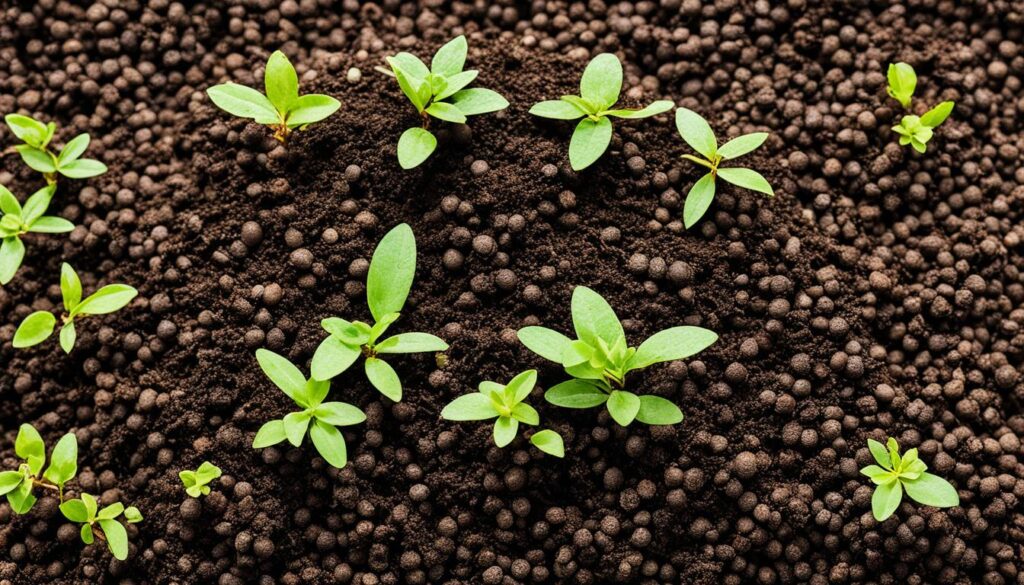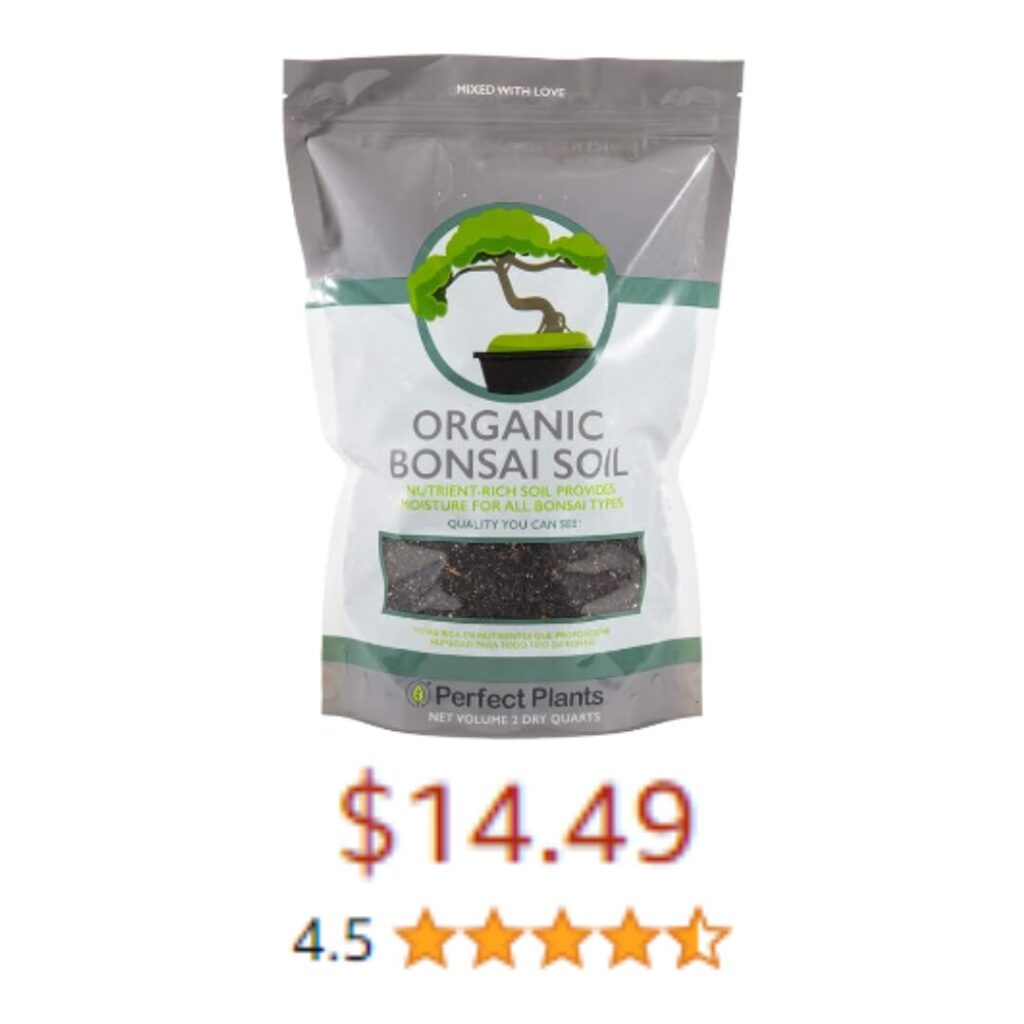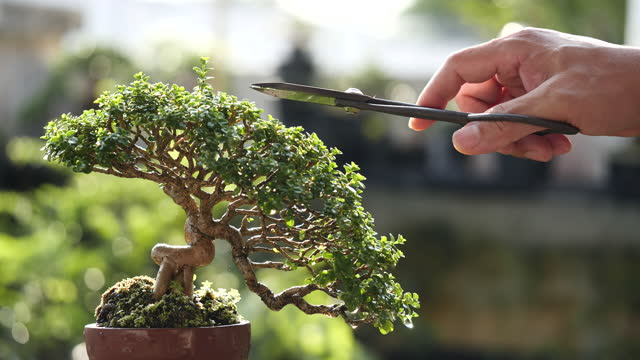Choosing the right soil is crucial for the health and vigor of bonsai trees. The quality of soil directly affects the growth and overall well-being of the plant.
Using garden soil can be harmful as it tends to harden when dry, making watering difficult. Good bonsai soil should have a balance of water retention, drainage, and aeration.
Organic and inorganic soils are the two main categories to consider. Organic soil components, such as peat and compost, break down over time and reduce drainage. In contrast, inorganic components like fired clays and volcanic rocks provide better drainage and aeration.
Popular soil ingredients for bonsai include Akadama, pumice, lava rock, organic potting compost, and fine gravel. Different tree species require different soil mixtures, such as deciduous bonsai soil and coniferous bonsai soil.
It is important to personalize your soil mix based on your tree’s needs and evaluate commercial bonsai tree soil mixes. Additionally, climate and pH levels play a role in adapting soil mixtures for bonsai.
Regular assessment and amendments are necessary for maintaining healthy bonsai tree soil. Insights from expert bonsai cultivators can provide valuable information on soil choices, and troubleshooting common issues with bonsai soils is essential. Tips for finding quality soil ingredients online and locally will help bonsai enthusiasts source the best soil for their trees.
The Importance of Choosing the Right Soil for Bonsai
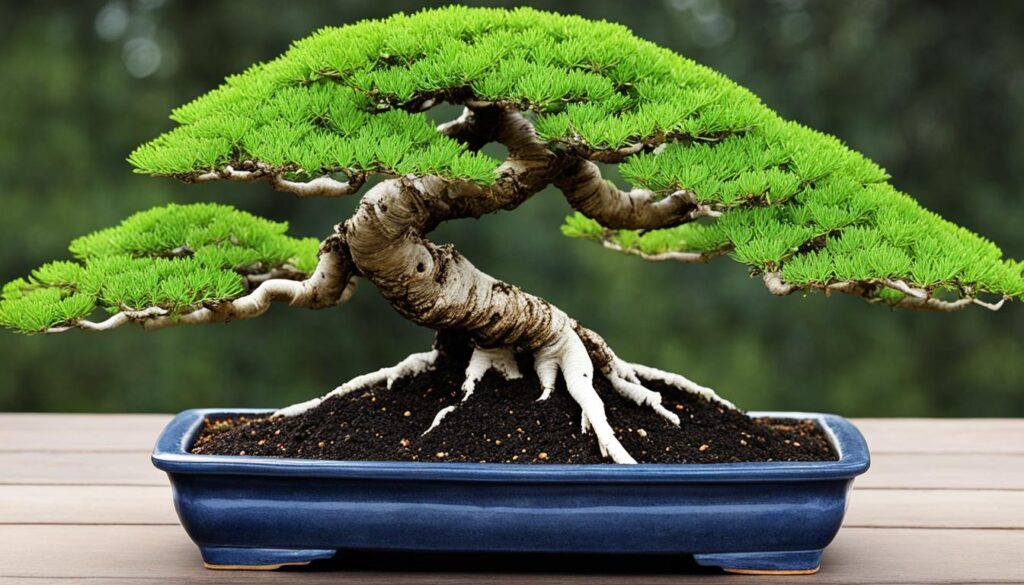
The quality of soil directly impacts the health and vigor of bonsai trees. Choosing the right soil is crucial for their overall well-being. Soil provides the necessary nutrients, water, and aeration for the roots to grow and thrive. Poor soil quality can lead to stunted growth, root rot, and even the death of the bonsai.
Why Soil Quality Matters for Bonsai Health and Vigor
The importance of soil quality cannot be overstated when it comes to the health and vigor of bonsai trees. High-quality soil ensures that the roots receive the necessary nutrients, water, and oxygen they need to thrive. Good soil composition promotes robust root development, which is essential for overall tree health and growth. It also improves the tree’s ability to withstand environmental stressors and disease.
The right soil provides a balanced environment for the roots, allowing for proper water retention, drainage, and aeration. This balance ensures that the tree’s roots are neither waterlogged nor deprived of moisture. It allows for optimal nutrient uptake and prevents the risk of root rot and other root-related issues. When the soil quality is poor, the bonsai tree may suffer from nutrient deficiencies, weakened immune system, and reduced overall vitality.
By choosing the right soil for your bonsai, you can provide the optimal conditions for its growth, ensuring that it remains healthy and vibrant for years to come.
Dangers of Using Garden Soil for Bonsai Trees
Using garden soil for bonsai trees can pose several dangers to their health. Garden soil tends to harden when dry, making it difficult to water the bonsai properly. It lacks the necessary balance of water retention, drainage, and aeration that is essential for the health of bonsai trees.
Furthermore, garden soil may contain weeds, pests, and diseases that can harm the bonsai. Contaminated soil can introduce harmful pathogens and pests that can weaken and even kill the tree. Additionally, garden soil may not provide the ideal nutrient composition required for bonsai tree growth, leading to nutrient deficiencies.
For these reasons, it is crucial to avoid using garden soil and instead opt for specially formulated bonsai tree soil that meets the specific needs of your tree.
Understanding Bonsai Soil Composition
Bonsai soil composition plays a crucial role in the overall health and vitality of your bonsai tree. To create an ideal environment for your bonsai, it’s important to understand the characteristics of good bonsai soil mixes and the balance of water-retention, drainage, and aeration.
Good bonsai soil mixes have the following characteristics:
- Water retention: Bonsai soil should have the ability to hold sufficient moisture for the tree between waterings. This helps prevent the roots from drying out and provides essential hydration.
- Drainage: Proper drainage is essential to prevent waterlogging and root rot. Excess water should be able to flow out of the pot easily, ensuring the well-being of the bonsai.
- Aeration: Aeration is crucial for the root system as it allows oxygen to reach the roots, promoting healthy growth. Bonsai soil should provide adequate airflow to the roots, facilitating nutrient absorption and overall tree health.
By achieving the right balance of these characteristics in your bonsai soil mix, you can create an optimal environment for the growth and development of your bonsai tree.
Organic vs. Inorganic Bonsai Soils

When it comes to choosing the right soil for your bonsai, you have two main options: organic and inorganic. Each type of soil has its own unique characteristics and benefits that can significantly impact the health and growth of your bonsai tree.
Pros and Cons of Organic Soil Components
Organic bonsai soil is composed of natural materials such as peat, compost, and bark. These components offer some advantages but also come with a few drawbacks.
Pros of organic soil components:
- Improved water retention: Organic materials have the ability to hold moisture, ensuring that your bonsai tree receives adequate hydration between watering sessions.
- Nutrient supply: Organic soil components slowly release nutrients over time, providing a steady source of nourishment for your bonsai.
Cons of organic soil components:
- Drainage issues: Over time, organic materials can break down and become compacted, reducing the soil’s drainage capabilities. This can lead to waterlogging and root rot if not managed properly.
- Decomposition: As organic components decompose, they can create smaller particles that further reduce drainage and aeration. This can negatively impact the health of your bonsai’s roots.
While organic soil can be beneficial, it requires regular monitoring and potential amendments to maintain optimal conditions for your bonsai.
Benefits of Inorganic Components for Drainage and Aeration
Inorganic bonsai soil, on the other hand, is composed of materials such as fired clays and volcanic rocks. These components offer several benefits that contribute to improved drainage and aeration.
Benefits of inorganic soil components:
- Enhanced drainage: Inorganic materials do not decompose like organic ones, ensuring that water flows through the soil and does not become stagnant. This helps to prevent root rot and other water-related issues.
- Improved aeration: Inorganic components create air pockets in the soil, allowing oxygen to reach the roots. This promotes healthy root growth and overall tree vigor.
- Stability: Inorganic materials provide stability to the soil structure, preventing compaction and maintaining open spaces for root development.
Inorganic soil components offer long-term benefits for bonsai trees, as they do not degrade over time like organic materials. They provide a stable and well-draining environment for healthy root growth.
Top Inorganic Soil Ingredients for Bonsai
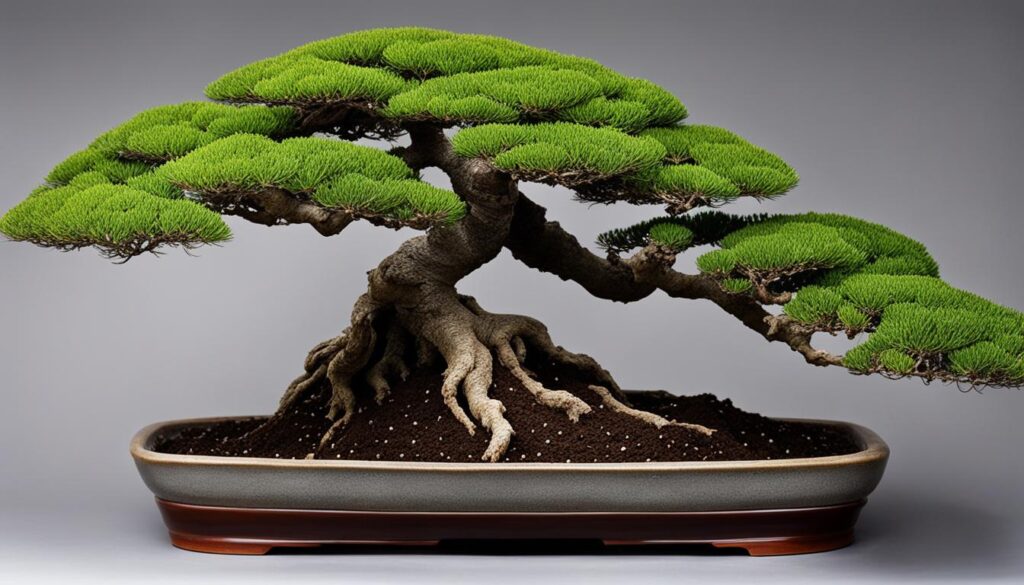
Inorganic soil ingredients play a significant role in creating a well-draining and aerated bonsai soil. These ingredients provide the necessary structure and balance for the roots to thrive. Two popular inorganic soil ingredients for bonsai are fired clays and volcanic rocks.
Discovering the Role of Fired Clays and Volcanic Rocks
Fired clays, such as Akadama, are specifically produced for bonsai purposes. Akadama has unique properties that make it an excellent choice for bonsai tree soil. It helps improve water retention while providing adequate drainage and aeration. When sifted and used in a mix, Akadama creates an optimal environment for bonsai tree roots to grow and expand.
Volcanic rocks, including pumice and lava rock, also play a vital role in bonsai soil mixes. These rocks contribute to the overall drainage and aeration of the soil. Pumice, in particular, is known for its ability to retain water and nutrients while promoting root ramification. This helps create a healthy and robust root system for bonsai trees.
By incorporating fired clays like Akadama and volcanic rocks into your bonsai soil mix, you can ensure proper drainage, aeration, and water retention – key factors in maintaining the health and vitality of your bonsai trees.
| Inorganic Soil Ingredient | Role in Bonsai Soil | Unique Properties |
|---|---|---|
| Akadama | Improves water retention, drainage, and aeration | Specifically produced for bonsai purposes |
| Pumice and lava rock | Contribute to drainage and aeration | Retains water and nutrients, promotes root ramification |
How the Right Bonsai Soil Affects Watering and Feeding
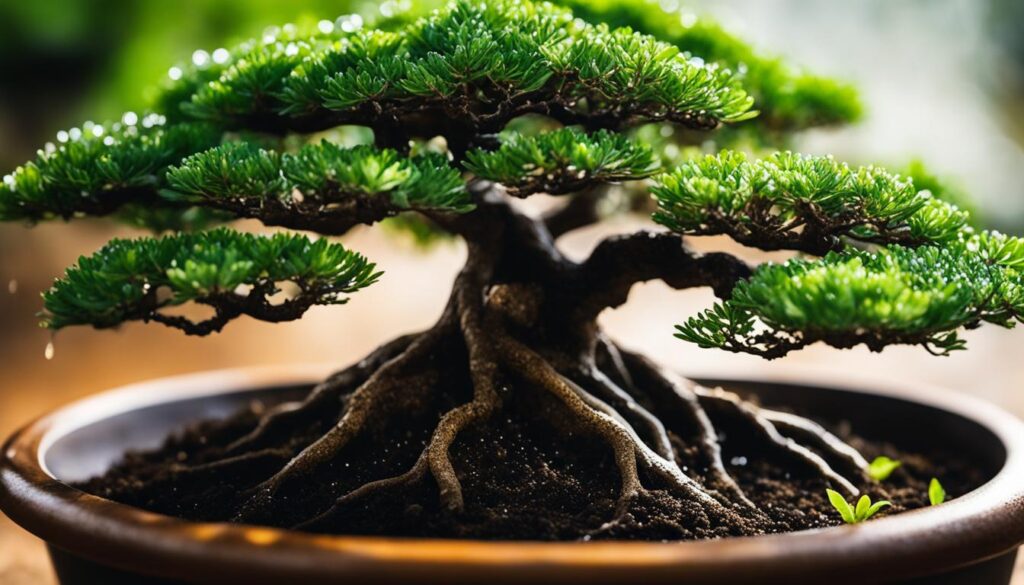
The right bonsai soil composition plays a crucial role in watering and feeding practices. Well-draining soil allows for proper water flow through the pot, preventing waterlogging and ensuring the roots receive sufficient hydration without rotting.
Adequate drainage also helps in nutrient absorption by preventing nutrient buildup that can lead to salt accumulation and root damage. Bonsai tree soil with good aeration allows the roots to breathe and uptake nutrients effectively. The right soil composition, therefore, directly affects the watering and feeding routines necessary for the bonsai’s optimal health and growth.
The Scoop on Organic Potting Composts and Bonsai

When it comes to creating the perfect soil mix for your bonsai, organic potting compost can play a vital role. This type of compost is typically a blend of organic materials that can enhance the overall health and growth of your bonsai trees.
When to Use Peat, Perlite, and Sand in Your Bonsai Mix
Within the organic potting compost, three key components that are commonly used in bonsai soil mixes are peat, perlite, and sand. Each of these components serves a specific purpose in creating a well-balanced bonsai mix.
Peat: Peat is known for its excellent water retention capabilities. Adding peat to your bonsai mix can help ensure that your trees receive adequate moisture between waterings, promoting healthy root development.
Perlite: Perlite is a lightweight volcanic rock that improves drainage and aeration. It helps prevent waterlogging and ensures the roots have access to oxygen, which is crucial for their overall health and vigor.
Sand: Sand aids in drainage and provides stability to the soil mix. Additionally, it contributes to aeration, allowing airflow through the roots and promoting healthy root growth.
When using these organic components in your bonsai mix, it’s important to consider the specific needs of your bonsai species and the desired characteristics of the soil mix. The proportions of peat, perlite, and sand can be adjusted based on these factors, allowing you to create an optimal growing environment for your bonsai trees.
A Review of Popular Bonsai Soil Mixes
Choosing the right soil mix is essential for the health and vitality of your bonsai trees. Different tree species have specific soil requirements to support their growth. In this section, we will explore the recommended soil mix ratios for deciduous bonsai and coniferous and pine bonsai.
Deciduous Bonsai Soil Mix Ratios
Deciduous bonsai trees, such as maple and elm, thrive in a soil mix that provides the right balance of water retention, drainage, and aeration. The recommended soil mix ratio for deciduous bonsai is typically 50% Akadama, 25% pumice, and 25% lava rock. This composition allows for adequate water retention while ensuring proper drainage and aeration for the roots.
Coniferous and Pine Bonsai Soil Formulations
Coniferous and pine bonsai have different soil formulation requirements compared to deciduous trees. The recommended soil mix for these bonsai types generally consists of equal parts Akadama, pumice, and lava rock, each comprising approximately 33% of the mix. This balanced composition provides the ideal conditions for coniferous and pine bonsai, promoting healthy root development and overall tree health.
It is important to note that these soil mix ratios may vary based on the specific needs of your tree and your personal preferences as a bonsai cultivator. Experimentation and observation are key to finding the perfect soil mix that best suits your bonsai’s requirements.
Custom Mixes vs. Pre-Made Soil

Bonsai enthusiasts have the option to create custom soil mixes or purchase pre-made bonsai soil mixes. Custom mixes allow you to personalize your bonsai tree soil to meet the specific needs of your tree. By adjusting the proportions of different soil components, you can achieve the perfect balance of water retention, drainage, and aeration for your bonsai. This personalized approach ensures that your tree receives the optimal growing conditions it requires.
On the other hand, pre-made bonsai soil mixes offer convenience and consistency. These mixes are specifically formulated for bonsai cultivation, saving you time and effort in creating your own custom mix. They often contain a well-balanced blend of soil components that provide the necessary properties for healthy bonsai growth.
When evaluating commercial bonsai soil mixes, it’s important to consider the quality of the components. Look for mixes that use high-quality soil ingredients to ensure the long-term health of your bonsai. Consider the reputation of the manufacturer and read reviews or seek feedback from other bonsai growers to determine the effectiveness of the soil mix.
Ultimately, the choice between custom and pre-made bonsai soil mixes depends on your preferences and the specific needs of your tree. Some bonsai enthusiasts enjoy the creative process of customizing their own soil mix, while others prefer the convenience and reliability of pre-made mixes. Whatever option you choose, the most important factor is to prioritize the health and well-being of your bonsai by providing it with the best soil possible.
How to Adapt Bonsai Soil Mixtures for Your Climate
Climate plays a significant role in the adaptation of bonsai soil mixtures. Factors such as rainfall, wind exposure, and watering habits need to be considered when creating the ideal soil mix for your bonsai tree.
Accommodating for Rainfall
In regions with heavy rainfall, it is important to adjust the soil mix to allow for faster drainage and prevent waterlogging. Excessive moisture can lead to root rot and other health issues. By incorporating components that promote better drainage, such as pumice or lava rock, you can create a soil mix that can effectively handle the increased rainfall.
Managing Wind Exposure
Areas with high winds can cause the soil to dry out quickly, resulting in poor water retention. To counteract this, you may need to include components in your bonsai soil mix that help retain more moisture, such as Akadama or organic potting compost. These materials can help create a more stable moisture level and prevent your bonsai from drying out too quickly.
Adjusting Watering Habits
Your watering habits should also align with the climate you are in. In drier climates, you may need to water your bonsai more frequently to compensate for the lack of natural rainfall. This may require a soil mix that retains moisture for longer periods, such as one with higher proportions of Akadama or organic potting compost.
Understanding the specific needs of your bonsai tree in relation to the climate it is grown in is crucial for creating the most suitable soil mix. By adapting your bonsai soil mixtures to accommodate factors like rainfall, wind exposure, and watering habits, you can provide optimal growing conditions for your bonsai and ensure its health and vitality.
pH Levels and Their Impact on Bonsai Soil Mixes
The pH levels of the soil have a significant impact on the quality and health of bonsai soil mixes. pH refers to the acidity or alkalinity of the soil, and it plays a vital role in nutrient availability to the roots of bonsai trees. The pH level directly affects the absorption and uptake of essential minerals necessary for the bonsai’s growth and development.
Different bonsai species have distinct pH requirements to thrive optimally. Some species prefer acidic soil, while others thrive in neutral or slightly alkaline conditions. Understanding the specific pH requirements of your bonsai tree is essential for selecting the appropriate soil mix and creating the ideal growing environment. By providing the right pH levels, you can ensure that your bonsai tree has access to the nutrients it needs to flourish.
When determining the pH levels of your bonsai tree soil, it is crucial to conduct regular soil testing. This will give you valuable insights into the acidity or alkalinity of the soil and allow you to make any necessary adjustments. pH testing kits are readily available and easy to use, enabling you to monitor and maintain the optimal pH levels for your bonsai trees.
Creating a Bonsai Soil Mix: A Step-by-Step Guide
Creating the ideal soil mix for your bonsai is essential for its growth and overall health. The right balance of water retention, drainage, and aeration is key to providing the necessary environment for your bonsai tree to thrive. Here is a step-by-step guide to help you create a bonsai soil mix that meets your tree’s needs:
- Start with a base material: Begin by selecting a high-quality base material that provides good drainage. Akadama, a fired clay soil component, is a popular choice for bonsai soil mixtures. It offers excellent water retention while allowing adequate drainage.
- Add an aggregate for improved aeration: To enhance aeration, incorporate an aggregate material into the mix. Pumice and lava rock are commonly used aggregates that provide air pockets within the soil, promoting root health and oxygen circulation.
- Include organic matter for nutrient retention: To ensure your bonsai receives the necessary nutrients, add organic matter to the soil mix. This can include components such as compost or a high-quality organic potting mix. Organic matter helps retain nutrients and promotes microbial activity in the soil.
- Customize ratios based on tree species: Different bonsai species have varying needs when it comes to soil composition. Research the specific requirements of your tree species and adjust the ratios of the base material, aggregate, and organic matter accordingly.
- Blend thoroughly: Combine the base material, aggregate, and organic matter in a large container or on a tarp. Thoroughly mix the components together until they are well-blended and evenly distributed throughout the soil.
- Test the soil mix: Before using the soil mix for your bonsai, perform a simple test to ensure it has the desired characteristics. Squeeze a handful of the soil mix in your hand and then release. It should hold its shape briefly before crumbling. This indicates a good balance of water retention and drainage.
- Adjust as needed: If the soil mix is too sandy and doesn’t retain enough water, add more organic matter. If it retains too much water and is clay-like, increase the amount of aggregate. Continuously test and adjust the soil mix until you achieve the desired properties.
Creating a bonsai soil mix may require some experimentation and adjustment to find the perfect blend for your tree’s specific needs. By following this step-by-step guide, you can create a well-balanced soil mix that provides optimal conditions for your bonsai’s growth and longevity.
The Role of Mycorrhizae in Bonsai Soil Health
Mycorrhizae play a vital role in ensuring the health and vitality of bonsai soil. These beneficial fungi establish a mutually beneficial relationship with the roots of bonsai trees, providing numerous advantages. By forming a network of hyphae, mycorrhizal fungi enhance nutrient absorption by the roots, making them more efficient in acquiring essential elements from the soil. They also aid in water absorption, improving the tree’s ability to utilize moisture effectively.
Incorporating mycorrhizal fungi into the bonsai soil mix can have a profound positive impact on the overall health and growth of the tree. These fungi not only enhance nutrient uptake but also contribute to root development, increasing the root surface area and enabling optimal nutrient and water absorption. The symbiotic relationship between mycorrhizal fungi and bonsai trees ultimately results in improved vigor, resilience, and longevity.
To ensure the presence of mycorrhizae in your bonsai tree soil, you can either introduce them through commercially available inoculants or promote their natural colonization by maintaining a healthy and diverse soil ecosystem. By providing a suitable habitat and proper care, you can encourage the growth and establishment of mycorrhizal fungi in your bonsai soil, reaping the benefits of this symbiotic relationship.
In the journey to maintain bonsai soil health, understanding the role of mycorrhizae and actively incorporating them into your soil mix can significantly contribute to the long-term success of your bonsai trees.
DIY Bonsai Soil Mixes: Ingredients to Avoid
Creating your own bonsai soil mix can be a cost-effective and rewarding way to care for your bonsai tree. However, it’s important to be aware of certain ingredients that should be avoided to ensure the health and well-being of your tree.
When selecting soil components for your DIY bonsai soil mix, keep in mind the following common mistakes and ingredients to avoid:
- Garden Soil: Garden soil is not suitable for bonsai trees as it tends to compact and harden when dry, making it difficult for water to penetrate and drain properly. It also lacks the necessary balance of water retention, drainage, and aeration that bonsai trees require.
- Topsoil: Similar to garden soil, topsoil is not ideal for bonsai trees due to its poor drainage and potential for compaction. It may also contain weed seeds, pests, and diseases that can harm your bonsai.
- Low-Quality Potting Mix: Using a low-quality potting mix can lead to various issues such as poor drainage, compaction, and inadequate aeration. It’s essential to select a high-quality potting mix specifically formulated for bonsai or opt for individual soil components.
By avoiding these ingredients and selecting high-quality soil components, you can create a DIY bonsai soil mix that provides the necessary water retention, drainage, and aeration for your tree’s optimal growth.
Testing and Adjusting Your Bonsai Soil Over Time
Regularly testing and adjusting your bonsai soil is essential for maintaining optimal soil conditions to promote the health and vitality of your bonsai trees. By assessing the water retention, drainage, and aeration of the soil, you can make necessary adjustments to ensure your bonsai’s long-term well-being.
Observing how your bonsai tree responds to watering is a practical way to assess the water retention of the soil. By observing the moisture levels in the pot and the time it takes for the soil to dry out after watering, you can determine if the soil is retaining too much or too little water. If the soil retains too much water, it can lead to root rot and other moisture-related issues.
On the other hand, if the soil dries out too quickly, it may indicate poor water retention, which can negatively impact the tree’s health. Adjusting the proportions of specific components in your soil mix, such as increasing the percentage of organic matter for better water retention or adding inorganic materials for improved drainage, can help achieve a balanced water retention level.
In addition to assessing water retention, it is crucial to evaluate the drainage and aeration of your bonsai soil. Proper drainage allows excess water to flow out of the pot, preventing waterlogging and the development of root rot. If you notice that water takes a long time to drain or remains stagnant in the pot, it is an indicator that the soil mix may need adjustment.
Similarly, inadequate aeration can hinder root growth and nutrient absorption. If you find that the soil is compacted or lacks sufficient aeration, you can consider incorporating materials like volcanic rocks or pumice into your soil mix to improve aeration and prevent compaction.
Regular assessment and adjustment of your bonsai soil composition ensures that your tree’s specific needs are met, resulting in healthier and more vibrant growth.
Soil amendments are another important aspect of maintaining optimal bonsai soil conditions. As your bonsai tree grows, it may require additional nutrients to support its development. By periodically incorporating organic matter, such as compost or slow-release fertilizer, into the soil, you can provide essential nutrients that promote healthy root growth and overall tree health.
It is advisable to research the specific nutrient requirements of your bonsai species and consult with experienced bonsai cultivators to determine the most suitable amendments for your tree’s needs.
Regularly testing and adjusting your bonsai soil composition ensures that your tree’s specific needs are met, resulting in healthier and more vibrant growth. By closely monitoring the water retention, drainage, and aeration of the soil, and making necessary adjustments and amendments, you can create an optimal soil environment that supports the overall health and longevity of your bonsai trees.
Troubleshooting Common Issues with Bonsai Soils
Bonsai soils, like any other type of soil, can sometimes present challenges and issues that need to be addressed for the health and well-being of the tree. Understanding common issues and knowing how to fix them is essential for maintaining the overall health and vitality of your bonsai. Here are some common problems with bonsai soils and tips for troubleshooting:
Poor Drainage
Poor drainage is a common issue with bonsai soils. If the soil retains too much water and doesn’t drain properly, it can lead to root rot and other problems. To improve drainage, you can:
- Assess your soil mix: Check if there is an imbalance of components that could be causing poor drainage. Adjust the proportions of organic and inorganic materials accordingly.
- Increase aeration: Incorporate inorganic components like pumice or volcanic rocks into the soil mix to promote better aeration and drainage.
- Amend the soil: If the soil is too compacted, add coarse sand or perlite to loosen it up and improve drainage.
Compacted Soil
Compacted soil can hinder root growth and prevent proper water and nutrient absorption. To address compacted soil:
- Aerate the soil: Gently loosen the soil around the roots using a root hook or chopstick. Be careful not to damage the roots in the process.
- Repotting: If the soil is severely compacted, consider repotting the bonsai. Replace the old soil with fresh, well-draining soil to promote healthy root growth.
Excessive Water Retention
Excessive water retention can result in waterlogging, leading to root rot and other issues. Here’s how you can tackle this problem:
- Assess soil composition: Check if the soil mix contains organic components that have broken down and are holding too much water. Adjust the soil mix by reducing the organic component and increasing the inorganic material.
- Add inorganic materials: Incorporate materials like pumice or lava rock into the soil mix to improve drainage and reduce water retention.
- Watering practices: Adjust your watering schedule and ensure that you’re not overwatering the bonsai. Allow the soil to dry out slightly between waterings to prevent waterlogging.
Inadequate Aeration
Inadequate aeration can hinder root development and inhibit the uptake of oxygen, leading to poor tree health. To enhance aeration:
- Assess soil structure: Check if the soil mix is compacted or if the particles are too fine. Incorporate coarse materials like pumice or perlite into the mix to improve aeration.
- Repotting: If the existing soil is preventing proper aeration, consider repotting the bonsai with fresh, well-aerated soil.
By troubleshooting common issues with bonsai soils, you can ensure that your bonsai trees have the optimal growing environment they need to thrive.
This page contains some affiliate links. Please refer to our affiliate disclaimer for more information

Karen Phillips, Bonsai expert and blogger. Read more about me here

